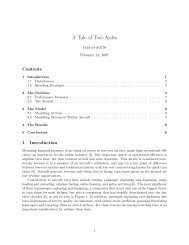Neural Models of Bayesian Belief Propagation Rajesh ... - Washington
Neural Models of Bayesian Belief Propagation Rajesh ... - Washington
Neural Models of Bayesian Belief Propagation Rajesh ... - Washington
Create successful ePaper yourself
Turn your PDF publications into a flip-book with our unique Google optimized e-Paper software.
246 11 <strong>Neural</strong> <strong>Models</strong> <strong>of</strong> <strong>Bayesian</strong> <strong>Belief</strong> <strong>Propagation</strong> <strong>Rajesh</strong> P. N. Rao<br />
Recurrent Network Model<br />
To detect motion using <strong>Bayesian</strong> inference in the above HMM, consider first<br />
a model based on the linear recurrent network as in equation (11.18) but with<br />
normalization as in equation (11.23) (which makes the network nonlinear). We<br />
can compute the recurrent weights mij for the transition probabilities given<br />
above using the approximation method in equation (11.24) (see figure 11.4D).<br />
The resulting network then implements approximate belief propagation for the<br />
HMM based on equation (11.20-11.23). Figure 11.5 shows the output <strong>of</strong> the network<br />
in the middle <strong>of</strong> a sequence <strong>of</strong> input images depicting a bar moving either<br />
leftward or rightward. As shown in the figure, for a leftward-moving bar at a<br />
particular location i, the highest network output is for the neuron representing<br />
location i and direction L, while for a rightward-moving bar, the neuron representing<br />
location i and direction R has the highest output. The output firing<br />
rates were computed from the log probabilities log m t,t+1<br />
i using a simple linear<br />
encoding model: fi = [c · vi + F ] + where c is a positive constant (= 12 for this<br />
plot), F is the maximum firing rate <strong>of</strong> the neuron (= 100 in this example), and<br />
+ denotes rectification. Note that even though the log-likelihoods are the same<br />
for leftward- and rightward-moving inputs, the asymmetric recurrent weights<br />
(which represent the transition probabilities) allow the network to distinguish<br />
between leftward- and rightward-moving stimuli. The posterior probabilities<br />
m t,t+1<br />
i are shown in figure 11.5 (lowest panels). The network correctly computes<br />
posterior probabilities close to 1 for the states θiL and θiR for leftward<br />
and rightward motion respectively at location i.<br />
Rightward Moving Input<br />
Leftward Moving Input<br />
00<br />
−1<br />
−2 −2<br />
log likelihood<br />
0<br />
−1<br />
−2<br />
0 0<br />
−5<br />
−10<br />
−15<br />
100<br />
50 50<br />
5<br />
5<br />
10<br />
10<br />
15 20<br />
log posterior<br />
15 20<br />
firing rate<br />
25<br />
25<br />
30<br />
30<br />
0<br />
−5<br />
−10<br />
−15<br />
100<br />
50<br />
5<br />
5<br />
10<br />
10<br />
15<br />
15<br />
20<br />
20<br />
25<br />
25<br />
30<br />
30<br />
00<br />
11<br />
0.5 0.5<br />
5 10 15 20<br />
posterior<br />
25 30<br />
0<br />
1<br />
0.5<br />
5 10 15 20 25 30<br />
00<br />
1 5 10 15 20 25 30<br />
0<br />
1 5 10 15<br />
20 25 30<br />
Right selective neurons Left selective neurons Right selective neurons Left selective neurons<br />
Figure 11.5 Network Output for a Moving Stimulus (from [30]). (Left Panel) The four<br />
plots depict respectively the log likelihoods, log posteriors, neural firing rates, and posterior<br />
probabilities observed in the network for a rightward moving bar when it arrives<br />
at the central image location. Note that the log likelihoods are the same for the<br />
rightward and leftward selective neurons (the first 15 and last 15 neurons respectively,<br />
as dictated by the feedforward weights in Figure 11.4B) but the outputs <strong>of</strong> these neurons<br />
correctly reflect the direction <strong>of</strong> motion as a result <strong>of</strong> recurrent interactions. (Right<br />
Panel) The same four plots for a leftward moving bar as it reaches the central location.
















